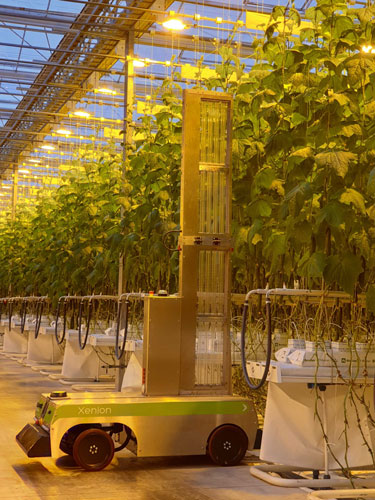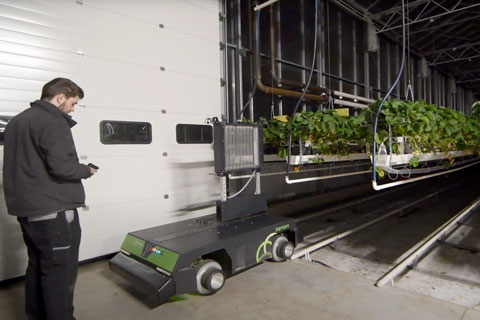5/1/2024
Making Use of UV-C
Chris Beytes

The use of ultraviolet light (UV) as a disinfectant is not new. Way back in 1877, researchers Downes and Blunt discovered that sunlight could prevent microbial growth, and UV’s use as a germicide has been well-documented since then. Its water sanitation capabilities are also well-known, and there’s even a body of research on using UV on plants. However, other than for water treatment, commercial tools for using UV in the greenhouse have been limited. But that is changing, thanks to new research and growers seeking sustainable pest control options.
Pictured: Octiva’s Lumion (on its Xenion platform) getting set to treat cucumbers.
What is UV light?
UV photons exist between 10 and 400 nanometers on the light spectrum, at the edge of the visible light (380 to 700 nm) that our eyes can see. There are three classifications of UV:
UV-A: long-wave ultraviolet, 320 nm to 400 nm. This provides vitamin D from the sun and a nice tan, but it can also cause sunburn, premature aging and can contribute to the growth of skin cancer (melanoma). In plants, UV-A can increase anthocyanins—the pigment that makes red leaf lettuce red or purple violas purple.
UV-B: shorter waves, 280 nm to 320 nm. The main cause of sunburn and a key contributor to melanoma and cataracts. Luckily, about 95% of UV-B is absorbed by the ozone in the atmosphere and doesn’t reach us.
UV-C: 100 to 280 nm, the shortest and most harmful waves, but thankfully almost completely absorbed by the Earth’s atmosphere.
The lower the number, the shorter the waves of photons, and the more energy those photons have, which is why UV is damaging to plastics (it’s why your poly roofs don’t last), plants and people. But that also means they can be damaging to organisms like insects, fungi, bacteria and viruses, making UV-C an effective non-chemical insect and disease control. UV-C can be used to sanitize irrigation water or, by suspending the lights above or below the crop, to directly target insects and diseases living on or around them. The primary challenge is knowing the dose: how much UV-C and for how long? Too much and you damage the plant along with the pest. This is where much of today’s research is focused.
How UV-C kills
UV-C works for pest control through a process known as ultraviolet germicidal irradiation (UVGI). It kills pests by damaging their DNA and RNA, disrupting cellular functions, and impairing their reproductive capacity. Repeated exposure has a cumulative effect on the pest. It’s a broad-spectrum treatment, affecting bacteria, viruses, fungi and some insect pests such as aphids, whiteflies, thrips and mites.
While pests can develop resistance to UV-C treatments, it is much less likely compared to chemical pesticides, because UV-C directly damages the DNA and RNA. And it leads to death or sterilization, rather than allowing pests to survive and reproduce with resistant traits. The key to preventing resistance is to avoid sub-lethal doses and exposure to protective environments (e.g. shaded areas).
How UV-C is deployed in the greenhouse
UV-C light can be applied in various ways within a greenhouse or vertical farm, including fixed installations of lamps strategically placed throughout the growing area, or mobile units that can be moved to target specific areas or crops. Automated systems can control the timing, duration and intensity of UV-C light exposure based on factors such as pest infestation levels, crop growth stages and environmental conditions.
Several competing companies, including Octiva (the Netherlands), Micothon (the Netherlands) and Advanced Intelligence Systems (AIS) (Canada) have developed autonomous robots that carry UV-C lamp arrays between the crop rows. Octiva’s robot is called Lumion, with models for strawberries and vine crops; Micothon also has two robots, Flora UVC and Narva UVC; AIS’ robot is called Phoenix. All function in much the same way: a self-guided autonomous vehicle carries the lamp array between the rows of plants, either on wheels or riding on the rails already installed in the growing area. They can operate at night when no humans are present. Light arrays can be short, for strawberries, tall for vine crop like tomatoes, or held horizontally over the top of a crop.
Floral growers can also take advantage of UV-C. Micothon’s Flora, with its boom-like lamp array, has been used to control powdery mildew and Botrytis on cut roses. And cut tulip growers in the Netherlands are using UV-C to control root diseases on their crops by passing the bulb trays over lamps positioned between the internal transport system rails, treating the exposed roots.
Treating irrigation water
Tomato growers are using UV-C to disinfect irrigation water against viruses like the Tomato Brown Rugose Fruit Virus (ToBRFV), which is highly contagious and can easily spread to plants through mechanical means such as contaminated hands, clothes and tools, and can rapidly spread through irrigation water in a hydroponic system. UV-C can also protect against other plant pathogens that may be present in water, such as Phytophthora and Pythium.
Challenges and opportunities
While UV-C light has shown promise in controlling pests in greenhouse and vertical farm settings, its effectiveness can vary depending on factors such as the type of pest, its life stage, the intensity and duration of UV-C exposure, and environmental conditions like humidity and temperature. For instance, research on powdery mildew on cucumbers showed that once-daily treatments with UV-C at 254 nm was effective against the disease, but it also reduced the leaf area of the plants, potentially reducing yield. Instead, the researchers found that a higher dose of UV-C every four days eliminated powdery mildew and didn’t affect the foliage size.
 In 2020, French researchers determined that on tomatoes, peppers, lettuce and grapevines, brief-but-repeated one-second flashes of UV-C were more effective than longer light exposure, and may even stimulate disease resistance within the plant.
In 2020, French researchers determined that on tomatoes, peppers, lettuce and grapevines, brief-but-repeated one-second flashes of UV-C were more effective than longer light exposure, and may even stimulate disease resistance within the plant.
Pictured: A worker gets ready to deploy a UV-C robot in a strawberry crop. Once operating, the robot can move from bay to bay autonomously.
Research at Cornell University has shown that UV-C can affect plant growth, acting as a growth regulator, enhancing branching, but also reducing plant height and delaying flowering. This could potentially serve as an alternative to chemical growth regulators, but more research needs to be done.
It’s important to note that UV-C light is extremely harmful to humans and beneficial organisms if not used properly. Operators must take precautions to ensure that personnel are not exposed to direct UV-C light, either by using automated systems or implementing safety protocols such as warning signs and protective barriers. That’s why UV-C is often deployed at night, after workers have left for the day.
However, used correctly, the benefits seem to outweigh the risk: UV-C systems are relatively easy to implement, are cost-effective, require no re-entry period, reduce chemical use, improve the overall health of your crops, and can help you comply with existing and new regulations regarding chemical use and runoff water sanitation.
Overall, as UV-C technology becomes more tested, proven and widespread, it will be an excellent tool to consider adding to your IPM arsenal.